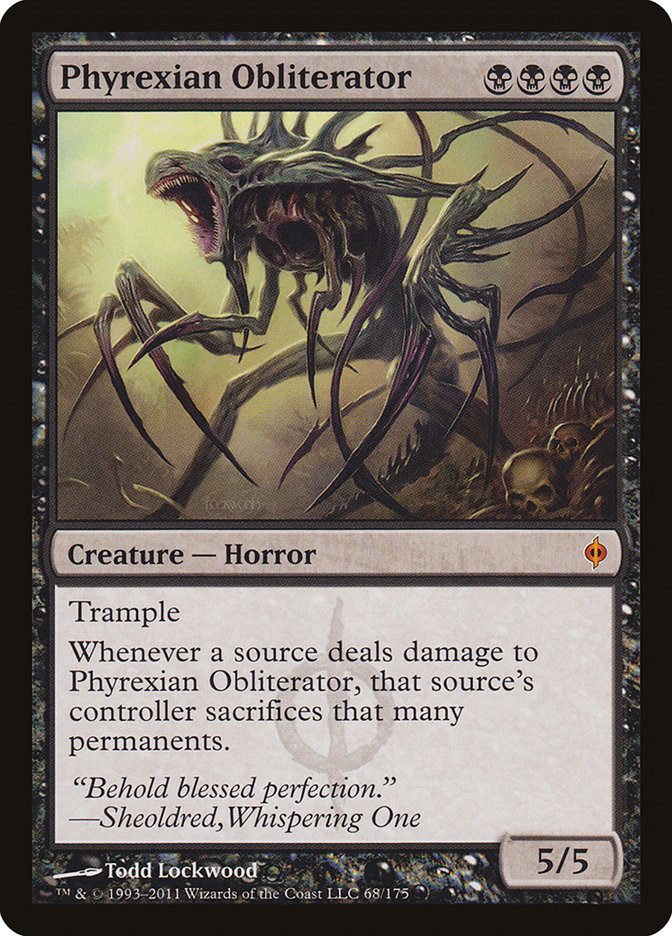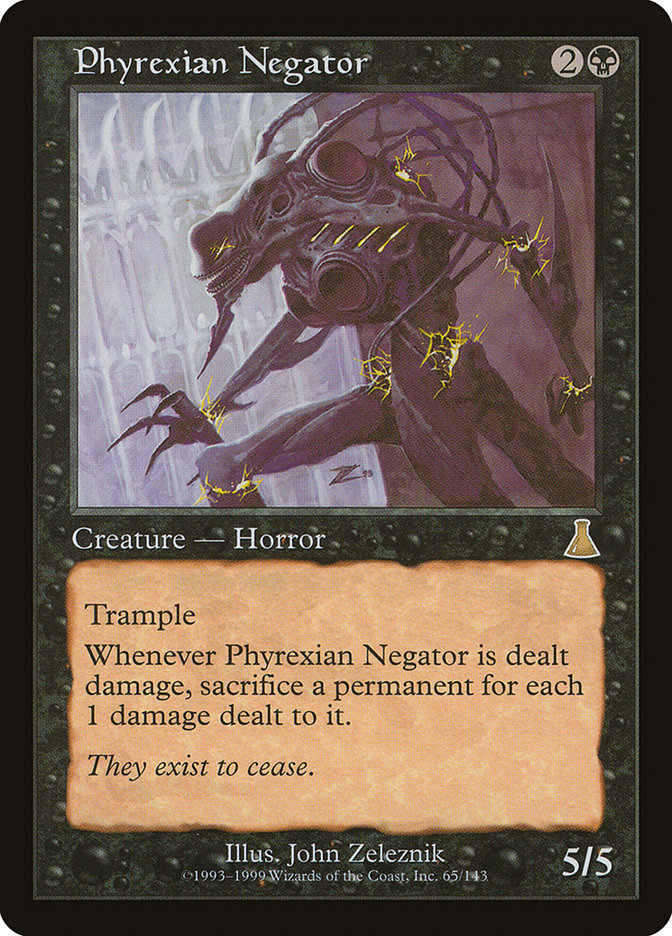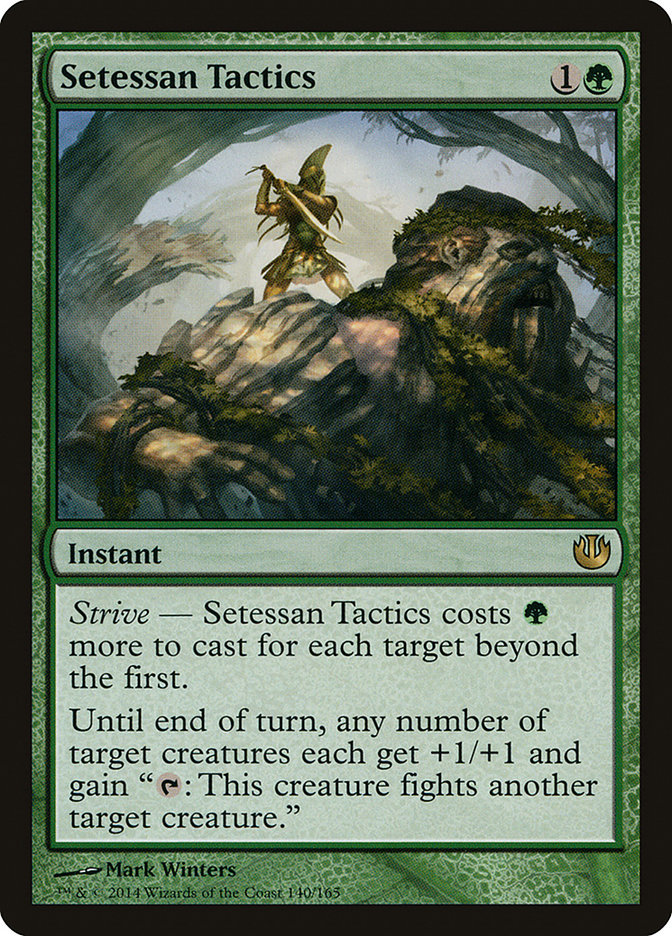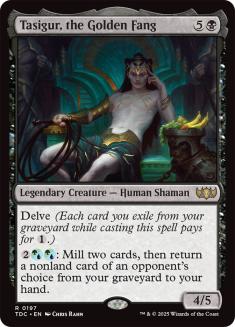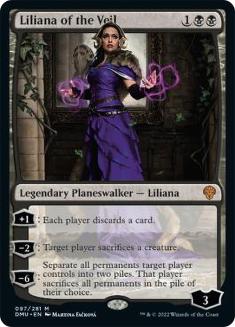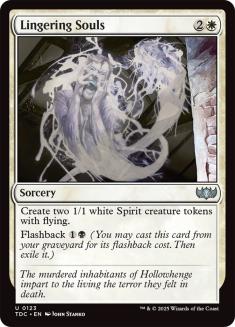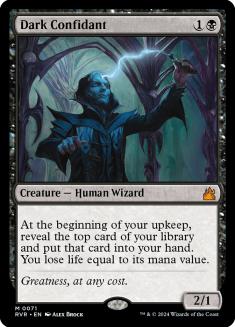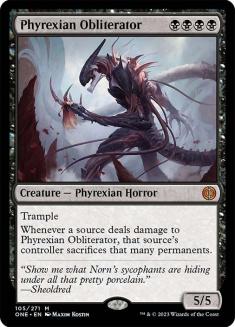People sometimes ask me why I play unusual decks. At Grand Prix Omaha, in a world full of Treasure Cruise
and Birthing Pod, people told me they wondered, “Why are you playing a B/G Midrange deck?!”
The answer was simple: because my deck was beating those decks.
I had Phyrexian Negator’s big brother: I had Obliterator.
For a long time in Modern, I’d see people playing decks without Phyrexian Obliterator, and I just felt like they were on the wrong side of a
dispute. Obliterator was just so intensely powerful for me, I couldn’t imagine going any other way.
After Siege Rhino was created, inevitably, I’d hear the questions: Why limit yourself to only black and green? Siege Rhino is the best creature for Abzan
Midrange, and playing white is just more access to great cards to play! Again, I’d say, “Obliterator is just better.”
And I still firmly stand beside that claim.
Rhino Versus Horror
Here is the largest reason I have preferred Phyrexian Obliterator to Siege Rhino: Siege Rhino makes a game-changing impact the moment it comes into play
and Phyrexian Obliterator makes a game-changing impact the entire time it is in play.
The horrible Horror in play would create suicide situations for a whole slew of decks. It was like a Moat: Aggressive decks would be forced to take to the
air, sit back and not attack. If they did attack, truly horrible things could happen. In essence, they had to attack for the kill, or risk the
likely end of their game right then and there. If you were in a position to attack with the Phyrexian Obliterator, the only thing they could generally do
is simply let it through. There would be no chumping with a Kitchen Finks to gain a modicum of life. Chumping would be something only two people would do:
chumps, or the truly desperate.
Rhino simply didn’t do that. Even the lifegain that it provided was actually, in practice, not that much compared to an Obliterator. Making the three
colors of mana work would, in general, cost the deck a few points of life more than making the mana work for two colors. The second Rhino would
certainly be a powerful force for stabilizing, but even then, comparing it to the Moat-effect of the Obliterator left Siege Rhino wanting. Against pure
Burn, Siege Rhino was certainly the better card, but in most instances, Obliterator was just the bigger effect of the two.
Now, this is all assuming that the card has come into play. It is easy to say that one card “in play” is better than another. That’s because we get to
ignore the casting costs.
If we ignore casting costs and just are able to put the card into play, which of the two is better?
What about this pair?
So obviously, when talking about comparing Siege Rhino and Phyrexian Obliterator, we can’t ignore the very real costs of both cards in terms of casting
cost.
For Phyrexian Obliterator, things are very complicated. Deciding to use any single land that can’t cast Phyrexian Obliterator can make the card have an
effective casting cost of +1 (or more, in the case of more lands). Every non-black source is a source that cannot be used to cast the card. This means that
your deckbuilding is constrained greatly. This certainly matters, especially when you aren’t running a card like Tectonic Edge – which further cascades
into making a card like Fulminator Mage less effective, and thus hurts matchups where that kind of strategy could be useful.
For Siege Rhino, it is actually simple: Three colors of mana requires dedication to fixing each color, and this can be a careful balancing act, and it will
certainly cost you a touch more life. That being said, you are in a position to actually run between one and three colorless land, which can be a
hugely powerful boon to a deck. This balance is certainly very achievable, but it also does mean that there are going to be games where you’re failing to
cast some spell or another. Let’s look at the most recent Abzan Midrange deck I helped work on for an example of this.
Creatures (14)
Planeswalkers (4)
Lands (24)
Spells (18)

This deck was mostly the result of the work Brian Kowal, Matt Severa, Ben Rasmussen, and I put into the archetype over many hours of work in Magic Mecca
Madison, Wisconsin. Ostensibly, this manabase creates eighteen green sources, sixteen black sources, and fifteen white sources. Of course, this isn’t
exactly correct because every fetchland is not a Mana Confluence or City of Brass. While two fetchlands can generally grab you all three colors,
it comes at a hefty cost of life, can easily be disrupted by any number of cards, and sometimes your colors are quite strained.
We spent a lot of time on this manabase (and I still think we may have been one card off), and we did manage to find room for two mana that were
“off-color” (in that they had no color). In a deck like this, Siege Rhino is absolutely the way to go simply because the strain you’d put on the deck for
Obliterator made it inhospitable for the Horror. At the time, I was simultaneously working on a pure B/G Midrange deck with Phyrexian Obliterator, but I
recommended this deck over it because I thought the white cards brought something important into the mix for this metagame.
I’ve had enough success with Obliterator builds, I’d like to give you a tour of those last few years and show you what I’d do in Modern with the deck now.
Grand Prix Chicago 2012
I only had one bye at this event, and I finished at 11-4 in 59th place. I went into this event not fully prepared honestly, and I was just hoping to enjoy
myself. I’d worked on my deck quite a bit via Magic Online, and so I felt comfortable with all of my card choices, but looking back, I can definitely see
that I made some mistakes. Here was that deck:
Creatures (19)
Planeswalkers (4)
Lands (23)
Spells (14)

In an era where Deathrite Shaman was legal, this deck was just vicious. Accelerating into a third turn Obliterator is incredible. In addition to that
though, dropping a second turn Hypnotic Specter is just cruel.
While it is true that there were a ton of cards that kill Hypnotic Specter, not only do people not necessarily have them in their hand right away, but
sometimes they don’t have the second removal spell, or the third. In essence, the deck was full of lightning rods, and you didn’t want to have any
of the creatures stick around. The classic argument against Phyrexian Obliterator is that it takes so much work to put it on the table, and then someone
can just kill it. This is true, but when so many creatures are asking to be killed, and you run disruption, this can be a real strain.
Pyromancer Ascension was one of the big decks of the moment, and this deck was incredibly effective at making life miserable for that deck. With so many
hand disruption cards, they would inevitably have to go for a rapid swarming of stormy Goblins, and then Vampire Nighthawk (of all things!) was yet another
in a series of cards that made that plan just not work.
A lot of people look at three Tarmogoyf as a surprise, but honestly, with Deathrite Shaman feeding on graveyards, I only wanted enough Tarmogoyfs to
regularly see them, not drown in them. The card was there to be able to start some aggression if need be, be another card to potentially draw the Path to
Exile, and more often than not, hold the fort.
The big mistake of this deck was not recognizing just how good Twilight Mire was; if I’d known, I would have likely had access to three or four Treetop
Village, which I think would have been an excellent addition.
In that metagame, Phyrexian Obliterator did some incredible work, holding off endless Tarmogoyfs from both aggressive and midrange decks. One of my four
losses was to Jund, but I beat more Jund than I lost to. Other than that, I lost to a nightmare matchup (Tron), a friend from Madison playing Burn (in a very close match), and had a match-losing mistake versus Splinter Twin. Obliterator played a significant role in all of these matchups except the
Twin matchup where it was simply too slow, even with the acceleration from Deathrite Shaman.
In many ways here, the card worked because it was a Tarmogoyf world, and a Horror is scarier than a Lhurgoyf.
Grand Prix Minneapolis 2014
I did not play Obliterator Rock in Minneapolis, but in retrospect, I wish I had. I got seduced by a Delver deck that felt very exciting but had a
terrible, terrible Affinity matchup. Four of my first five rounds were against Affinity. I only beat one of them.
I stepped away from Obliterator Rock for this event because I was quite tired of how bad the Tron matchup was. Solving this problem showcased the real cost
of Phyrexian Obliterator: not playing Tectonic Edge, thus making Fulminator Mage less powerful. Even then, those aren’t full solutions to the matchup by
any means.
Still, against most other matchups, I was doing very well with this deck. This is the version I was playing a lot before and after Grand Prix Minneapolis,
including taking it to a few minor cash finishes.
Creatures (16)
Planeswalkers (3)
Lands (24)
Spells (17)

The big decks weren’t very different than they would be a short while later: Jund was the big midrange deck instead of Abzan, Pod was huge, Jeskai Control,
Affinity, and Twin variants were all big. I loved this deck against all of those decks.
Unfortunately, Scapeshift was also reasonably well-represented. That and Tron required minor miracles to beat.
This is actually where a little miracle in the sideboard comes into play:
This combo is so good, I would bring it in against an incredible array of decks. Twin was about the only deck you didn’t bring it in against. In essence,
the Setessan Tactics + Phyrexian Obliterator combo was there to just steal a win that you had no business having otherwise. Tron was a matchup where you
couldn’t expect to win in a fair fight. But you could get off a lucky Tactics + Obliterator hit and steal a win. Versus Pod, you’d grind them down with
your other cards, and at some point a Tactics would seal the (already otherwise good) deal. Scapeshift was a little more tricky to beat: They’d have to
actually bring in their creatures for you to Tactics, and you’d have to steal another game in there somewhere, but it was a doable, if difficult
proposition.
This deck wasn’t as discard-heavy as the previous deck, but it was slightly more built to grind. Claw the opponent’s resources up and kill them with
something. Phyrexian Obliterator was only a three-of here because it couldn’t race to the table, and it served as the top-end of the deck’s curve, with the
extra Obliterator there in the sideboard as a way to exploit Tactics (or to bring in when you wanted a Moat).
Grand Prix Omaha 2015
Now we get close to the present with Grand Prix Omaha. I had a little bit of buzz about my deck going into the
event. I’d been trying to solve the Treasure Cruise addled world of Modern when it occurred to me that Chalice of the Void didn’t actually really hurt
Obliterator Rock much at all. If you simply cut all of the discard, Chalice could take care of that role in a way. Some other tweaks would have to be made
to accommodate the idea, but there was certainly something there.
Of course, the idea had to be tested. And I was surprised that the deck just utterly decimated Delver decks. Before the event, Matt Sperling sat down with
me just to see, and he walked away satisfied that the deck did its job. Between attacking Delver decks and continuing to crush Pod and Abzan, I was feeling
pretty well situated. Here’s the deck:
Creatures (18)
Lands (24)
Spells (18)

Here, a single Tactics moved to the maindeck and another one found its way into the sideboard. Without all of the one-casting-cost cards, I felt like I
needed to speed the deck up, and Lotus Cobra came to the rescue, returning Phyrexian Obliterator to its place as a potential turn 3 play. With the Cobra
also comes Sword of Fire and Ice as another thing to do with fast mana. Some of the strange cards in the sideboard (Nightmare Void and Uba Mask) end up
being a concession to needing more disruption without being able to rely on cheap discard.
I started out early with a quick pair of losses to my worst matchups (Tron and Scapeshift), but I also beat Tron and Scapeshift, all on the back of
Setessan Tactics. I beat every Pod and Abzan deck I played against, but I lost in my final round against Merfolk and lost one of my three matches against
Delver from a play mistake.
From the time before Treasure Cruise was printed all the way until the Grand Prix, I’d been testing Setessan Tactics, just in general, and I’d gotten to
the point that I knew it was a powerful weapon for the deck. A singleton copy was never too much for the deck to get bogged down with the card, and
sideboard copies were great against all of the matchups where you needed an effect like that. In the past, I’d tried out Pit Fight as a cute, proto-
version of Setessan Tactics, but that card was just a trick rather than something powerful. The difference with Setessan Tactics is that sometimes you
could just use it to pump up your attacking team and kill someone. You could combine it with an attack as an incredible combat trick. You could steal
matches with Obliterator, but because it was a card you could target multiple creatures with, you never really got blown out by a removal spell in
response. Instead, the removal only shrunk the pain that your opponent felt rather than truly alleviated it.
This was a deck that was aiming at a specific target. This can be hard to do in a metagame as large as Modern, but the warping nature of Birthing Pod and
Treasure Cruise really helped the deck out, squeezing a ton of decks to the sidelines, and letting the deck focus in. At GP Memphis, Patrick Chapin told me
he thought those were the kinds of formats I excel in: the ones where there are big targets to shoot.
Obliterator worked here because it was a part of a larger gameplan of squeezing the opponent out of options. Not only did Obliterator and Chalice work well
together to accomplish that task, but Obliterator could finish up a game incredibly well as well, more so than ever, thanks to the possibility of a Sword
of Fire and Ice-wielding Horror.
Post-Pro Tour Fate Reforged, Post-Dragons of Tarkir
I already mentioned that leading into Pro Tour Fate Reforged, I was working on this deck but didn’t end up advocating for it. A huge part of the reason was
the influence that one single card had on the format:
It wasn’t so much that Tasigur, the Golden Fang was a problem for the deck, but rather that the card was so damned good that it drew everyone and their
mother to Abzan Midrange. If you did any testing at all, you probably ended up with this set of cards:
There were other cards that you’d have as well, but these were a key. In the past, Jund was generally a more likely opponent, and so you wouldn’t
necessarily see Lingering Souls at all, or it would be out of a more fragile Ajundi deck. By the time Omaha came around, all of the pure Abzan Midrange
decks had been pushed out by Pod lists; no Abzan Midrange list ended up with a better record than my Obliterator Rock. Without a resilient source of card
advantage, it just ended up that all of those decks naturally drifted into being Pod.
Now though, there was a real fight in the world of midrange for my deck, and Lingering Souls was not just a central part of that fight but a winning part of that fight.
In addition, Amulet Bloom was now a part of the metagame. Without the fuel provided by Dark Confidant, you could simply have too little disruption to do
what you needed. At the same time, Dark Confidant was a very dangerous card in a world where Burn was also a major part of the metagame.
Altogether, I just didn’t have the time to finish the work necessary to get a deck ready to the point that the Abzan Midrange deck was brought to. I’m
quite proud of our work on that deck, especially if you look at the Top 8 of the Pro Tour. Our group was pretty scattered on decks for the event, basically
playing everything under the sun. I think the Abzan deck was a good one, and it is probable that it was definitely a better choice than the Obliterator
Rock list.
Now, however, we have some targets to aim at.
I’d like to say that there are great new cards in Dragons of Tarkir that excite me for the deck. Virulent Plague, for example, looks incredible, until you
remember Illness in the Ranks exists. Minister of Pain is a reasonable card, but then you remember Marsh Casualties (or Profit//Loss). Ultimately, one of
the best things for Obliterator Rock in Dragons of Tarkir is simply how little the set affects much of Modern (regardless of how mindblowing the set seems
to be in Standard).
This means that the targets haven’t moved.
Here is my current build of Obliterator Rock, shooting at Abzan Midrange, Amulet Bloom, and an overall diverse metagame:
Creatures (15)
Planeswalkers (4)
Lands (24)
Spells (17)

The maindeck has been set up with more Thoughtseizes than I’ve run in a long time. This makes the deck weaker against the most aggressive decks but does
mean that you’re going to be more able to hit otherwise problematic expensive cards (Tasigur, Scapeshift, Karn Liberated, Primeval Titan, and Hive Mind).
In addition, the deck runs the full Dark Confidant/Liliana of the Veil package. Like Reid Duke, I’m not so convinced that Dark Confidant is strictly
overshadowed by Tasigur. I spent two afternoons testing nearly identical Abzan Midrange decks against each other, running Dark Confidant versus Tasigur,
and what the matchup seemed to boil down to was actually just getting Lingering Souls advantage. This deck doesn’t have access to that card, but in order
to maximize the power of Dark Confidant, the extra discard helps (and also adds in an additional need for lifegain, represented by an extra Scavenging Ooze
and a Batterskull).
Ultimately, the deck is set up to try to maximize the ability to disrupt an opponent. This does mean that the deck is eschewing Tasigur, however. To fit in
Tasigur, I think you’d want to do the following
Out:
In:
The extra Ooze will be useful in helping to regulate the graveyard to increase the power of Tasigur. At the same time, more very tough creatures tend to
strain an opponent’s ability to deal with the next such creature. Adding in the fourth Obliterator in that configuration seems powerful.
Despite the power of the card, without anything to accelerate the deck towards it, it is less a card you want to see in your opening hand, and more a card
that you want to see in most games. Like before, I run the singleton in the board as a card I bring in when I want the “Moat-effect” or if I’m bringing in
the full set of Setessan Tactics.
Illness in the Ranks and Marsh Casualties in the board are there as a means to fight Lingering Souls. In addition though, Marsh Casualties is just a
generally good card against small creatures. Illness in the Ranks, on the other hand, is just a pure silver bullet.
Perhaps the strangest card in the board was something suggested to me by Caleb Durward:
I’m still experimenting with this card, but the idea seems sound. It is a reasonable card to be able to make your Tarmogoyf punch through, as a Lingering
Souls suddenly just becomes a speedbump on defense, as any attempt to trade has to reckon with deathtouch. This by itself is really interesting. Beyond
that though, it can pick off fliers or just serve as a source of life. I know that Willy Edel has been a champion of the card, and I generally like his
approach to midrange decks.
Right now, this is the deck I’m enjoying the most in Modern. I’m still trying to figure out all of the small details (is Dark Confidant worse than Tasigur?
Am I doing enough against Affinity? etc.), but many of those details are actually specific to particular metagames.
Obliterator continues to impress me though. Until things change more, I expect to be playing Obliterator Rock for the foreseeable future in Modern.


